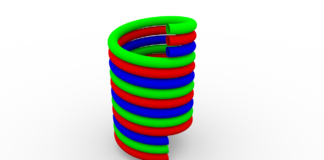Bifacial technology refers to a solar photovoltaic technology that enables solar panels to capture sunlight from both sides, increasing the overall energy generation efficiency of the panels. This innovative approach has gained significant traction in the renewable energy sector, offering a range of advantages over traditional monofacial solar panels. Here are the key aspects to understand about bifacial technology:
Increased Energy Yield: Bifacial solar panels have the distinct advantage of capturing sunlight not only from the front but also from the rear side, harnessing reflected and diffuse light, as well as albedo light from the ground. This increased light absorption capability results in higher energy yield compared to monofacial panels, making bifacial technology a promising solution for maximizing energy output in various geographical locations and environmental conditions.
Albedo Gain: The ability of bifacial solar panels to utilize reflected light from the ground, structures, and surrounding surfaces, known as albedo gain, contributes significantly to their enhanced energy generation efficiency. By capturing and converting this additional light into electricity, bifacial panels can achieve a substantial increase in energy production, particularly in areas with high ground reflectivity, such as snow-covered regions, deserts, and locations with light-colored surfaces.
Versatile Applications: Bifacial technology’s versatility extends to various installation settings, including ground-mounted systems, rooftop installations, and solar tracking systems. Its adaptability to diverse environments and mounting configurations makes it an attractive option for solar projects with different spatial requirements and energy generation goals. Furthermore, its compatibility with both single-axis and dual-axis tracking systems further enhances its flexibility and potential for optimized energy output.
Optimized Performance in Diffuse Light Conditions: Bifacial solar panels demonstrate superior performance in diffuse light conditions, enabling them to generate electricity efficiently even in overcast or partially shaded environments. Their ability to utilize a broader spectrum of light, including scattered and diffused sunlight, allows them to maintain a consistent energy production level, making them an ideal choice for regions characterized by variable weather patterns and intermittent cloud cover.
Enhanced Durability and Longevity: Bifacial solar panels are designed with durable materials and advanced manufacturing techniques that ensure their longevity and robust performance over extended periods. Their resistance to environmental factors such as temperature fluctuations, humidity, and UV exposure contributes to their long-term reliability and stability, minimizing the need for frequent maintenance and replacement, and thus reducing overall operational costs.
Potential for Lower Levelized Cost of Electricity (LCOE): Bifacial technology’s ability to generate more energy per installed capacity, coupled with its enhanced performance in various light conditions, positions it as a viable option for achieving a lower levelized cost of electricity (LCOE). By maximizing energy yield and reducing the cost per kilowatt-hour of electricity generated, bifacial solar panels offer an economically competitive solution that aligns with the growing demand for cost-effective and sustainable energy production.
Advancements in Bifacial Module Design: Ongoing research and development efforts in the field of bifacial technology have led to significant advancements in module design, focusing on enhancing light-capturing efficiency, optimizing cell interconnection, and improving overall panel durability. These advancements, including the incorporation of advanced materials, novel cell configurations, and innovative manufacturing processes, have contributed to the continuous evolution and refinement of bifacial solar panels, further solidifying their position as a leading technology in the renewable energy sector.
Rising Adoption in Utility-Scale Projects: Bifacial solar technology has witnessed an increasing adoption rate in utility-scale solar projects, owing to its capacity to deliver higher energy output and its cost-effectiveness over the operational lifespan of large-scale solar installations. As the demand for clean energy solutions continues to escalate, utility-scale bifacial solar projects are becoming increasingly prevalent, contributing to the diversification of the global energy mix and the advancement of sustainable energy transition initiatives worldwide.
Challenges and Considerations: While bifacial technology offers numerous advantages, it also presents certain challenges and considerations that require careful assessment during project planning and implementation. Factors such as optimal installation orientation, ground albedo variability, and the impact of soiling on rear-side light capture necessitate thorough feasibility studies and precise site evaluations to ensure the effective integration and optimal performance of bifacial solar panels. Additionally, the need for standardized testing methodologies and performance metrics remains essential in facilitating accurate comparisons and assessments of bifacial module efficiency and reliability across different manufacturers and installations.
Role in Sustainable Energy Transition: Bifacial technology plays a pivotal role in advancing the global transition toward sustainable energy production and reducing reliance on traditional fossil fuels. By offering an efficient and cost-effective solution for harnessing solar energy, bifacial solar panels contribute to the expansion of renewable energy capacity, the mitigation of greenhouse gas emissions, and the promotion of a more sustainable and environmentally conscious approach to electricity generation. As governments, businesses, and communities prioritize renewable energy adoption and climate action, bifacial technology stands as a key enabler of a cleaner, greener, and more sustainable energy future.
The ongoing evolution and widespread adoption of bifacial technology underscore its critical role in driving the global transition toward a more sustainable and environmentally responsible energy landscape. As the renewable energy sector continues to expand and diversify, the versatility, efficiency, and economic viability of bifacial solar panels position them as a key enabler of a more resilient and sustainable energy infrastructure. Furthermore, ongoing research and development initiatives aimed at enhancing the performance and cost-effectiveness of bifacial technology are expected to contribute to its continued growth and prominence in the renewable energy market.
The dynamic interplay between technological advancements, regulatory support, and market demand for clean energy solutions further amplifies the significance of bifacial technology in addressing pressing global challenges related to climate change, energy security, and sustainable development. By harnessing the power of sunlight and converting it into clean, renewable electricity, bifacial solar panels represent a tangible and scalable solution for reducing carbon emissions, mitigating the adverse impacts of climate change, and promoting the widespread adoption of sustainable energy practices on a global scale.
The integration of bifacial technology into comprehensive energy strategies and sustainable development initiatives reflects a collective commitment to fostering a more inclusive, equitable, and environmentally conscious future. With a growing emphasis on reducing carbon footprints, enhancing energy efficiency, and promoting green economic growth, the role of bifacial technology in supporting these overarching objectives remains pivotal. By enabling greater energy independence, reducing reliance on non-renewable energy sources, and contributing to the overall decarbonization of the energy sector, bifacial solar technology stands at the forefront of the global effort to build a more resilient, sustainable, and prosperous future for generations to come.
In conclusion, bifacial technology represents a transformative force in the realm of renewable energy, offering a compelling blend of efficiency, versatility, and sustainability that has the potential to reshape the global energy landscape. As the world transitions toward a more sustainable and environmentally conscious future, the continued advancement and integration of bifacial solar panels into the mainstream energy infrastructure will play a pivotal role in driving the shift toward cleaner, more accessible, and cost-effective energy solutions. By harnessing the power of sunlight from both sides of solar panels, bifacial technology exemplifies the boundless potential of human ingenuity and innovation in addressing complex environmental challenges and advancing the collective pursuit of a more sustainable and prosperous planet.














